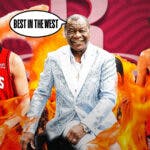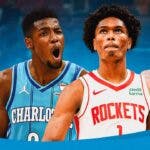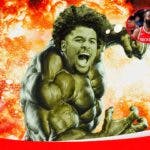When the Houston Rockets initially got the second overall pick of the 2021 NBA Draft, their fans were rightly split on who the franchise should draft. Cade Cunningham is the consensus number one overall pick, leaving a tantalizing tier of Evan Mobley, Jalen Suggs, and Jalen Green.
Then, the tide shifted heavily in the direction of a particular player. Pretty soon, Evan Mobley and Jalen Suggs were thoughts in fan discourse. At this moment in time, the majority of diehard Rockets fans will be upset if the name called at number two is not Jalen Green.
In a year where all the top draft experts can't seem to come up with a consensus number two overall pick, this is just a silly mentality to have. It may be obvious in a few years who the correct pick should have been, but it certainly isn't obvious right now.
Evan Mobley and Jalen Suggs both have solid cases to be the second best prospect in this draft and neither should be casually dismissed. In particular, Mobley has the talent and physical tools to make a team look foolish for passing on him.
The Main Knock: Position
If you genuinely believe Jalen Green is a better basketball prospect than Mobley, that's totally fine. Again, there isn't a consensus number two overall pick this year. After Cunningham, it's anyone's best guess who of this tier of players will end up having the best NBA career. It’s easy to construct a case for any of Mobley, Green, or Suggs.
However, if you can't form a cogent argument without using the phrase, ‘It's a guards league,' or some variation, your case just isn't strong enough. The modern NBA is not a guards league, it's a talent league. The best talents in the NBA typically possess two of the three qualities:
1) High level scoring
2) High level playmaking
3) Elite defense
For a second, let's reasonably assume that the ten best players in basketball are the following: Kevin Durant, LeBron James, Kawhi Leonard, Stephen Curry, Giannis Antetokounmpo, James Harden, Joel Embiid, Nikola Jokic, Damian Lillard, and Anthony Davis.
Three of these players are guards (Curry, Harden, and Lillard), three of these players are wings (Durant, James, and Leonard), and four of these players are bigs (Antetokounmpo, Embiid, Jokic, and Davis).
The last five NBA champions all had big men play major defensive roles (Draymond Green, Pascal Siakam, Anthony Davis, and Giannis Antetokounmpo/DeAndre Ayton).
For some reason, the big men who bust at the top of the draft stick with us, but for every Hasheem Thabeet, there’s an O.J. Mayo and for every Jahil Okafor, there’s a Markelle Fultz. Virtually every draft class has its own version of ‘busts' and there’s no correlation between the position one plays and the likelihood of them having successful careers. The draft is an impossible science that we have yet to crack after seventy years of trial and error.
All of this is to say this: The big man is not dead. However, it is true that more is required of modern day bigs to be above replacement level than twenty years ago. That only means one has to be extremely well rounded to be considered a top prospect in the draft. Fortunately for Houston, Evan Mobley does indeed fit that description.
It's completely unreasonable to let the letter next to someone's name dictate a critical decision like this.
A Reasonable Knock: Size and Strength
To call Evan Mobley slight-of-frame would be an understatement. The seven foot big man is rail-thin at 215 pounds and often got knocked around by smaller players for rebounding positioning. This resulted in Mobley averaging only 8.7 rebounds per game at USC – lower than your typical elite big man prospect.
Mobley may not be expected to be the next Andre Drummond, but rebounding is still a critical part of the modern game. Mechanically, there are also some things he will need to clean up in regards to bringing the ball down and staying low. This can be corrected with good NBA coaching, but the strength is something Mobley will need to continually work at.
Although post ups are a less prevalent attack than they were twenty years ago, they often rear their head in the playoffs in the form of attacking mismatches. If Mobley becomes an easy target by brute force bigs like Nikola Jokic and Joel Embiid, it doesn’t matter how mobile he is. Much like former Rockets center Clint Capela at the start of his NBA career, Mobley will get pulled in favor of a more forceful presence if he doesn’t add some muscle to his frame.
The main strength: Well… Everything else
This isn't an exaggeration. Evan Mobley is pretty much good at everything on the basketball court. He's a great defender, a capable scorer, and an instinctual passer. What really pops when watching Mobley's film is how gracefully he moves his feet.
— Salman Ali (@SalmanAliNBA) July 20, 2021
Seven footers aren't supposed to be this coordinated on both ends of the floor. Defensively, he's got exceptional lateral movement and good reaction timing. Offensively, he's basically an oversized small forward. He’s got guard skills and doesn’t look clumsy handling the ball or running the floor in transition.
Mobley will likely make his mark immediately on the defensive end, so let's start there. He's got excellent size at 7'0 with a 7'4 wingspan and this translated well to his rim protection abilities. Mobley showed he was particularly adept at blocking shots and protecting the rim without fouling. He averaged 2.9 blocks per game last year and played an incredible 33.9 minutes per game.
— Salman Ali (@SalmanAliNBA) July 20, 2021
Because of his unique lateral gifts, Mobley will be able to play multiple defensive schemes at the NBA level. While many bigs find themselves firmly in one camp or the other (drop coverage and switching), Mobley will be among a handful of big men in the league that can do both. This becomes particularly useful in the playoffs where teams try to run slow, plotting big men off the floor to get an open path to the basket. He will be able to play in these situations and adapt to different situations.
— Salman Ali (@SalmanAliNBA) July 20, 2021
Offensively, Mobley can score with his back to the basket thanks to the good touch he has with either hand. He can also score facing up and seems to have an eye for cutters when he's in the high post area. He may not be the hub of an offense, but teams will be able to comfortably run split-cuts and high/low offenses through him in spurts. Seldom does Mobley get blinders and become a black hole on offense as he's more often than not keeping the ball moving.
— Salman Ali (@SalmanAliNBA) July 20, 2021
The jump shot is an interesting case with Mobley because while his form looks fluid from mid-range (nearly 50%), he shot 30% from three-point range. He may eventually become a good three-point shooter at the NBA level or he could be a LaMarcus Aldridge type where he spaces the floor purely from mid-range. It’s anyone’s best guess at this point, but many people seem to be optimistic that it translates all the way.
— Salman Ali (@SalmanAliNBA) July 20, 2021
It's no secret that Mobley is a bit of an advanced stats darling and it's not hard to see why. These numbers feel like some kind of prank.
USC Trojans without Evan Mobley:
Offensive Rating: 90.7
Defensive Rating: 115.2
Net Rating: -24.5
USC Trojans with Evan Mobley:
Offensive Rating: 123.2
Defensive Rating: 90.9
Net Rating: +32.3
Here are Mobley's box plus-minus numbers compared to other recent elite big men prospect:
Evan Mobley:
Offensive: +7.9
Defensive: +5.8
Total: +13.7
Joel Embiid:
Offensive: +5.0
Defensive: +6.9
Total: +11.9
DeAndre Ayton:
Offensive: +8.6
Defensive: +2.4
Total: +11.0
Mobley's impact numbers are just ridiculous and track well with everything you see in film. USC did not have elite perimeter play, and outside of the Mobley brothers, there weren’t any NBA prospects on the team.
The bottom line:
Though the Rockets have a really tough decision to make at number two, Evan Mobley has arguably made the strongest case to be considered here. He's athletic, smart, and can play with any team configuration. He’s a worthy building block piece for a rebuilding team like Houston. While there’s always chance things he doesn’t pan out (as there is with any player), Mobley has done almost everything he can to erase doubt before entering the NBA.




